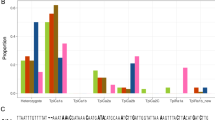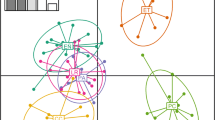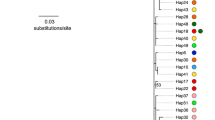Abstract
Purpose of Review
The genetic structure of insect vectors offers valuable insights for identifying panmictic units, reinfestation sources, and minimal intervention units in vector control programs. This review highlights key findings on the genetic structure of Triatoma infestans populations using microsatellites across various geographic scales and landscapes.
Recent Findings
Microsatellites have been employed to explore the genetic structure of T. infestans across Argentina, Bolivia, Paraguay, Brazil, and Peru. Research has focused on understanding genetic structure, assessing the impacts of short and long-distance migration, identifying sources of reinfestation post-insecticide spraying, evaluating the effects of insecticides on variability, and investigating the potential contribution of sylvatic foci to household infestation.
Summary
Triatoma infestans populations are highly structured across countries, landscapes, and geographical levels. Although support for the isolation-by-distance migration model is mixed, most studies point to a combination of active and passive dispersal. Insecticide spraying significantly influences genetic structure, intensifying differentiation. Reinfestation is mainly attributed to internal residual foci at the village level. Finally, the contribution of sylvatic populations to (re)infestation varies across geographic areas.
Graphical Abstract


Similar content being viewed by others
References
Papers of particular interest, published recently, have been highlighted as: • Of importance •• Of major importance
Sarkar S. The founders of evolutionary genetics: the editor’s introduction. In: Sarkar S, editor. The founders of evolutionary genetics. Boston Studies in the Philosophy of Science. Dordrecht: Springer. 1992:1–22. https://doi.org/10.1007/978-94-011-2856-8.
Hubby JL, Lewontin RC. A molecular approach to the study of genic heterozygosity in natural populations. I. The number of alleles at different loci in Drosophila pseudoobscura. Genetics. 1996;54:577–94.
Heather JM, Chain B. The sequence of sequencers: the history of sequencing DNA. Genomics. 2016;107:1–8. https://doi.org/10.1016/j.ygeno.2015.11.003.
Behura SK. Molecular marker systems in insects: current trends and future avenues. Mol Ecol. 2006;15:3087–113. https://doi.org/10.1111/j.1365-294X.2006.03014.x.
Amiteye S. Basic concepts and methodologies of DNA marker systems in plant molecular breeding. Heliyon. 2021;7:e08093. https://doi.org/10.1016/j.heliyon.2021.e08093.
McCoy KD. The population genetic structure of vectors and our understanding of disease epidemiology. Parasite. 2008;15(3):444–8. https://doi.org/10.1051/parasite/2008153444.
Monteiro F, Marcet P, Dorn P. Population genetics of triatomines. In: Telleria J, Tibayrenc M, editors. American trypanosomiasis. Chagas disease one hundred years of research. Amsterdam: Elsevier; 2010:169–208. https://doi.org/10.1016/B978-0-12-384876-5.00008-3.
Gourbière S, Dorn P, Tripet F, Dumonteil E. Genetics and evolution of triatomines: from phylogeny to vector control. Heredity. 2012;108:190–202. https://doi.org/10.1038/hdy.2011.71.
Waleckx E, Gourbière S, Dumonteil E. Intrusive versus domiciliated triatomines and the challenge of adapting vector control practices against Chagas disease. Mem Inst Oswaldo Cruz. 2015;110(3):324–38. https://doi.org/10.1590/0074-02760140409.
Dujardin JP, Tibayrenc M, Venegas E, Maldonado L, Desjeux P, Ayala FJ. Isozyme evidence of lack of speciation between wild and domestic Triatoma infestans (Heteroptera: Reduviidae) in Bolivia. J Med Entomol. 1987;24:40–5. https://doi.org/10.1093/jmedent/24.1.40.
Noireau F, Flores R, Gutierrez T, Dujardin JP. Detection of sylvatic dark morphs of Triatoma infestans in the Bolivian Chaco. Mem Inst Oswaldo Cruz. 1997;92:583–4. https://doi.org/10.1590/S0074-02761997000500003.
Waleckx E, Depickère S, Salas R, Aliaga C, Monje M, Calle H, Buitrago R, Noireau F, Brenière SF. New discoveries of sylvatic Triatoma infestans (Hemiptera: Reduviidae) throughout the Bolivian Chaco. Am J Trop Med Hyg. 2012;86:455–8. https://doi.org/10.4269/ajtmh.2012.11-0205.
Bacigalupo BA, Segura MJA, García CA, Hidalgo CJ, Galuppo GS, Cattan PE. Primer hallazgo de vectores de la enfermedad de Chagas asociados a matorrales silvestres en la Región Metropolitana. Chile Rev Méd Chile. 2006;134:1230–6. https://doi.org/10.4067/S0034-98872006001000003.
Bacigalupo A, Torres-Pérez F, Segovia V, García A, Correa J, Moreno L, Arroyo P, Cattan PE. Sylvatic foci of the Chagas disease vector Triatoma infestans in Chile: description of a new focus and challenges for control programs. Mem Inst Oswaldo Cruz. 2010;105:633–41. https://doi.org/10.1590/s0074-02762010000500006.
Rolón M, Vega MC, Román F, Gómez A, Rojas de Arias A. First report of colonies of sylvatic Triatoma infestans (Hemiptera: Reduviidae) in the Paraguayan Chaco, using a trained dog. PLoS Negl Trop Dis. 2011;5:e1026. https://doi.org/10.1371/journal.pntd.0001026.
Ceballos LA, Piccinali RV, Berkunsky I, Kitron U, Gürtler RE. First finding of melanic sylvatic Triatoma infestans (Hemiptera: Reduviidae) colonies in the Argentine Chaco. J Med Entomol. 2009;46:1195–202. https://doi.org/10.1603/033.046.0530.
Ceballos LA, Piccinali RV, Marcet PL, Vazquez-Prokopec GM, Cardinal MV, Schachter-Broide J, Dujardin JP, Dotson EM, Kitron U, Gürtler RE. Hidden sylvatic foci of the main vector of Chagas disease Triatoma infestans: threats to the vector elimination campaign? PLoS Negl Trop Dis. 2011;5:e1365. https://doi.org/10.1371/journal.pntd.0001365.
Dias JCP. Southern Cone Initiative for the elimination of domestic populations of Triatoma infestans and the interruption of transfusion Chagas disease: historical aspects, present situation, and perspectives. Mem Inst Oswaldo Cruz. 2007;102:11–8. https://doi.org/10.1590/S0074-02762007005000092.
de Arias AR, Monroy C, Guhl F, Sosa-Estani S, Santos WS, Abad-Franch F. Chagas disease control-surveillance in the Americas: the multinational initiatives and the practical impossibility of interrupting vector-borne Trypanosoma cruzi transmission. Mem Inst Oswaldo Cruz. 2022;117:e210130. https://doi.org/10.1590/0074-02760210130.
WHO. Chagas disease in Latin America: an epidemiological update based on 2010 estimates. Wkly Epidemiol Rec. 2015;90:33–43.
Hopkins T, Gonçalves R, Mamani J, Courtenay O, Bern C. Chagas disease in the Bolivian Chaco: persistent transmission indicated by childhood seroscreening study. Int J Inf Dis. 2019;86:175–7. https://doi.org/10.1016/j.ijid.2019.07.020.
Dujardin JP, Tybayrenc M. Isoenzymes study of the principal vector of Chagas` disease: Triatoma infestans (Hemiptera: Reduviidae). Ann Soc Belg Med Trop. 1985;65:165–9.
Tautz D. Hypervariability of simple sequences as a general source for polymorphic DNA markers. Nucleic Acids Res. 1989;17:6463–71. https://doi.org/10.1093/nar/17.16.6463.
Gemayel R, Cho J, Boeynaems S, Verstrepen KJ. Beyond junk-variable tandem repeats as facilitators of rapid evolution of regulatory and coding sequences. Genes. 2012;3:461–80. https://doi.org/10.3390/genes3030461.
Abdul-Muneer PM. Application of microsatellite markers in conservation genetics and fisheries management: recent advances in population structure analysis and conservation strategies. Genet Res Int. 2014;2014:691759. https://doi.org/10.1155/2014/691759.
García BA, Zheng L. Pérez de Rosas AR, Segura EL Isolation and characterization of polymorphic microsatellite loci in the Chagas’ disease vector Triatoma infestans (Hemiptera: Reduviidae). Mol Ecol Notes. 2004;4:568–71. https://doi.org/10.1111/j.1471-8286.2004.00735.x.
Marcet PL, Lehmann T, Groner G, Gürtler RE, Kitron U, Dotson EM. Identification and characterization of microsatellite markers in the Chagas disease vector Triatoma infestans (Heteroptera: Reduviidae). Infect Genet Evol. 2006;6:32–7. https://doi.org/10.1016/j.meegid.2005.01.002.
Marcet PL. Análisis micro-geográfico de la estructura genético-poblacional de Triatoma infestans en comunidades rurales del Noroeste Argentino. Doctoral dissertation. 2009. Universidad de Buenos Aires, Facultad de Ciencias Exactas y Naturales. 2009.
Pérez de Rosas AR, Segura EL, García BA. Microsatellite analysis of genetic structure in natural Triatoma infestans (Hemiptera: Reduviidae) populations from Argentina: its implication in assessing the effectiveness of Chagas’ disease vector control programmes. Mol Ecol. 2007;16:1401–12. https://doi.org/10.1111/j.1365-294X.2007.03251.x. The first study of T. infestans microsatellite variation at a macrogeographic scale, comprising several Argentinean populations and including the impact of insecticide spraying over neutral variability.
Hardy O, Vekemans X. Isolation by distance in a continuous population: reconciliation between spatial autocorrelation analysis and population genetics models. Heredity. 1999;83:145–54. https://doi.org/10.1046/j.1365-2540.1999.00558.x.
Pérez de Rosas AR, Segura EL, García BA. Molecular phylogeography of the Chagas’ disease vector Triatoma infestans in Argentina. Heredity. 2011;107:71–9. https://doi.org/10.1038/hdy.2010.159.
Piccinali RV, Marcet PL, Noireau F, Kitron U, Gürtler RE, Dotson EM. Molecular population genetics and phylogeography of the Chagas disease vector Triatoma infestans in South America. J Med Entomol. 2009;46:796–809. https://doi.org/10.1603/033.046.0410.
Cortez MR, Monteiro FA, Noireau F. New insights on the spread of Triatoma infestans from Bolivia—implications for Chagas disease emergence in the Southern Cone. Inf Genet Evol. 2010;10:350–3. https://doi.org/10.1016/j.meegid.2009.12.006.
Pizarro JC, Gilligan LM, Stevens L. Microsatellites reveal a high population structure in Triatoma infestans from Chuquisaca. Bolivia PLoS Negl Trop Dis. 2008;2:e202. https://doi.org/10.1371/journal.pntd.0000202. One of the first studies of T. infestans genetic structure in Bolivia, including different geographic scales.
Pritchard JK, Stephens M, Donnelly P. Inference of population structure using multilocus genotype data. Genetics. 2000;155:945–59. https://doi.org/10.1093/genetics/155.2.945.
Hardy OJ, Charbonnel N, Fréville H, Heuertz M. Microsatellite allele size: a simple test to assess their significance on genetic differentiation. Genetics. 2003;163:1467–82. https://doi.org/10.1093/genetics/163.4.1467.
Brenière SF, Salas R, Buitrago R, Brémond P, Sosa V, Bosseno MF, Waleckx E, Depickère S, Barnabé C. Wild populations of Triatoma infestans are highly connected to intra-peridomestic conspecific populations in the Bolivian Andes. PLoS ONE. 2013;8:e80786. https://doi.org/10.1371/journal.pone.0080786.
Silva LJ. Desbravamento, agricultura e doença: a doenca de Chagas no Estado de São Paulo. Cad Saude Pub. 1986;2:124–40. https://doi.org/10.1590/S0102-311X1986000200002.
Belisário CJ, Pessoa GC, Silva EM, Rosa AC, Ferreira RE, Bedin C, Wilhelms T, de Mello F, Coutinho HS, Fonseca EL, Dos Santos RF, Rodrigues VL, Dias JC, Diotaiuti L. Genetic characterization of residual Triatoma infestans populations from Brazil by microsatellite. Genética. 2017;145:105–14. https://doi.org/10.1007/s10709-017-9949-y.
Piccinali RV, Gürtler RE. Fine-scale genetic structure of Triatoma infestans in the Argentine Chaco. Inf Genet Evol. 2015;34:143–52. https://doi.org/10.1016/j.meegid.2015.05.030.
Marcet PL, Mora MS, Cutrera AP, Jones L, Gürtler RE, Kitron U, Dotson, EM. Genetic structure of Triatoma infestans populations in rural communities of Santiago del Estero, northern Argentina. Inf Genet Evol. 2008;8(6):835–846. https://doi.org/10.1016/j.meegid.2008.08.002. One of the first studies of T. infestans genetic structure at a microgeographic scale comparing areas with regular and irregular vector control interventions.
Rannala B, Mountain JL. Detecting immigration by using multilocus genotypes. Proc Natl Acad Sci U S A. 1997;940:9197–201. https://doi.org/10.1073/pnas.94.17.9197.
Pérez de Rosas AR, Segura EL, Fichera L, García BA. Macrogeographic and microgeographic genetic structure of the Chagas’ disease vector Triatoma infestans (Hemiptera: Reduviidae) from Catamarca, Argentina. Genetica. 2008;133:247–60. https://doi.org/10.1007/s10709-007-9208-8.
Pérez de Rosas AR, Segura EL, Fusco O, Guiñazú AL, García BA. Fine-scale genetic structure in populations of the Chagas’ disease vector Triatoma infestans (Hemiptera, Reduvidae). Genetica. 2013;141:107–17. https://doi.org/10.1007/s10709-013-9710-0.
Slatkin M, Voelm L. FST in a hierarchical island model. Genetics. 1991;127:627–9. https://doi.org/10.1093/genetics/127.3.627.
Cecere MC, Vasquez-Prokopec GM, Gürtler RE, Kitron U. Reinfestation sources for Chagas disease vector, Triatoma infestans Argentina. Emerg Infect Dis. 2006;12:1096–102. https://doi.org/10.3201/eid1207.051445.
Porcasi X, Catalá SS, Hrellac H, Scavuzzo MC, Gorla DE. Infestation of rural houses by Triatoma infestans (Hemiptera: Reduviidae) in southern area of Gran Chaco in Argentina. J Med Entomol. 2006;43(5):1060–7. https://doi.org/10.1093/jmedent/43.5.1060.
Gurevitz JM, Gaspe MS, Enriquez GF, Provecho YM, Kitron U, Gürtler RE. Intensified surveillance and insecticide-based control of the Chagas disease vector Triatoma infestans in the Argentinean Chaco. PLoS Neg Trop Dis. 2013;7:e2158. https://doi.org/10.1371/journal.pntd.0002158.
Pérez-Cascales E, Sossa-Soruco VM, Brenière SF, Depickère S. Reinfestation with Triatoma infestans despite vigilance efforts in the municipality of Saipina, Santa Cruz, Bolivia: situational description two months after fumigation. Acta Trop. 2020;203:105292. https://doi.org/10.1016/j.actatropica.2019.105292.
Schofield CJ. Challenges of Chagas disease vector control in Central America. Global collaboration for development of pesticides for public health. WHO/CDS/WHOPES/GCDPP/2000. Geneva: World Health Organization. 2000:1–16.
Piccinali RV, Gaunt MW, Gürtler RE. A microsatellite-based analysis of house infestation with Triatoma infestans (Hemiptera: Reduviidae) after insecticide spraying in the Argentine Chaco. J Med Entomol. 2018;55:609–19. https://doi.org/10.1093/jme/tjx256. A study of the origin of reinfestant T. infestans after insecticide spraying in the Argentine Chaco, supporting the presence of residual foci.
Piccinali RV, Gaspe MS, Nattero J, Gürtler RE. Population structure and migration in Triatoma infestans (Hemiptera: Reduviidae) from the Argentine Chaco: an integration of genetic and morphometric data. Acta Trop. 2023;247:107010. https://doi.org/10.1016/j.actatropica.2023.107010.
Piccinali RV, Marcet PL, Ceballos LA, Kitron U, Gürtler RE, Dotson EM. Genetic variability, phylogenetic relationships and gene flow in Triatoma infestans dark morphs from the Argentinean Chaco. Infect Genet Evol. 2011;11:895–903. https://doi.org/10.1016/j.meegid.2011.02.013.
Richer W, Kengne P, Cortez MR, Perrineau MM, Cohuet A, Fontenille D, Noireau F. Active dispersal by wild Triatoma infestans in the Bolivian Andes. Trop Med Int Health. 2007;12:759–64. https://doi.org/10.1111/j.1365-3156.2007.01846.x.
Rojas de Arias A, Messenger LA, Rolon M, Vega MC, Acosta N, Villalba C, Marcet PL. Dynamics of Triatoma infestans populations in the Paraguayan Chaco: population genetic analysis of household reinfestation following vector control. PLoS One. 2022;17:e0263465. https://doi.org/10.1371/journal.pone.0263465. A study of the role of sylvatic T. infestans in reinfestation in different localities from the Paraguayan Chaco.
Mougabure-Cueto G, Picollo MI. Insecticide resistance in vector Chagas disease: evolution, mechanisms and management. Acta Trop. 2015;149:70–85. https://doi.org/10.1016/j.actatropica.2015.05.014.
Fronza G, Toloza AC, Picollo MI, Spillmann C, Mougabure-Cueto GA. Geographical variation of deltamethrin susceptibility of Triatoma infestans (Hemiptera: Reduviidae) in Argentina with emphasis on a resistant focus in the Gran Chaco. J Med Entomol. 2016;53(4):880–7. https://doi.org/10.1093/jme/tjw056.
Piccinali RV, Fronza G, Mougabure-Cueto GA, Toloza AC. Genetic structure of deltamethrin-resistant populations of Triatoma infestans (Hemiptera: Reduviidae) in the Gran Chaco. Parasitol Res. 2020;119:3305–13. https://doi.org/10.1007/s00436-020-06789-y.
Marcet PL, Santo-Orihuela P, Messenger LA, Vassena C. Insights into the evolution and dispersion of pyrethroid resistance among sylvatic Andean Triatoma infestans from Bolivia. Inf Genet Evol. 2021;90:104759. https://doi.org/10.1016/j.meegid.2021.104759.
Carbajal-de-la-Fuente AL, Sánchez-Casaccia P, Piccinali RV, Provecho Y, Salvá L, Meli S, Cano F, Hernández R, Nattero J. Urban vectors of Chagas disease in the American continent: a systematic review of epidemiological surveys. PLoS Negl Trop Dis. 2022;16:e0011003. https://doi.org/10.1371/journal.pntd.0011003.
Foley EA, Khatchikian CE, Hwang J, Ancca-Juárez J, Borrini-Mayori K, Quıspe-Machaca VR, Levy MZ, Brisson D, the Chagas Disease Working Group in Arequipa. Population structure of the Chagas disease vector, Triatoma infestans, at the urban–rural interface. Mol Ecol. 2013;22:5162–71. https://doi.org/10.1111/mec.12471.
Khatchikian CE, Foley EA, Barbu CM, Hwang J, Ancca-Juárez J, Borrini-Mayori K, Quıspe-Machaca VR, Naquira C, Brisson D, Levy MZ, Chagas Disease Working Group in Arequipa. Population structure of the Chagas disease vector Triatoma infestans in an urban environment. PLoS Negl Trop Dis. 2015;9:e0003425. https://doi.org/10.1371/journal.pntd.0003425.
Acknowledgements
The author thanks to Dr. A. C. Toloza for his kind invitation to enroll in this review and suggestions to make it amenable.
Funding
This work was supported by the Agencia Nacional de Promoción Científica y Tecnológica, grant PICT-2020-SERIEA-1975.
Author information
Authors and Affiliations
Contributions
RVP: Conceptualization, Data Curation, Formal Analysis, Funding Acquisition, Investigation, Visualization, Writing – Original Draft Preparation, Writing – Review & Editing.
Corresponding author
Ethics declarations
Conflict of Interest
The author declares no competing interests.
Human and Animal Rights and Informed Consent
This article does not contain any studies with human or animal subjects performed by the author.
Additional information
Publisher's Note
Springer Nature remains neutral with regard to jurisdictional claims in published maps and institutional affiliations.
Rights and permissions
Springer Nature or its licensor (e.g. a society or other partner) holds exclusive rights to this article under a publishing agreement with the author(s) or other rightsholder(s); author self-archiving of the accepted manuscript version of this article is solely governed by the terms of such publishing agreement and applicable law.
About this article
Cite this article
Piccinali, R.V. Triatoma infestans (Hemiptera: Reduviidae) Population Genetics: What Have We Learned from Microsatellites?. Curr Trop Med Rep (2024). https://doi.org/10.1007/s40475-024-00317-z
Accepted:
Published:
DOI: https://doi.org/10.1007/s40475-024-00317-z




